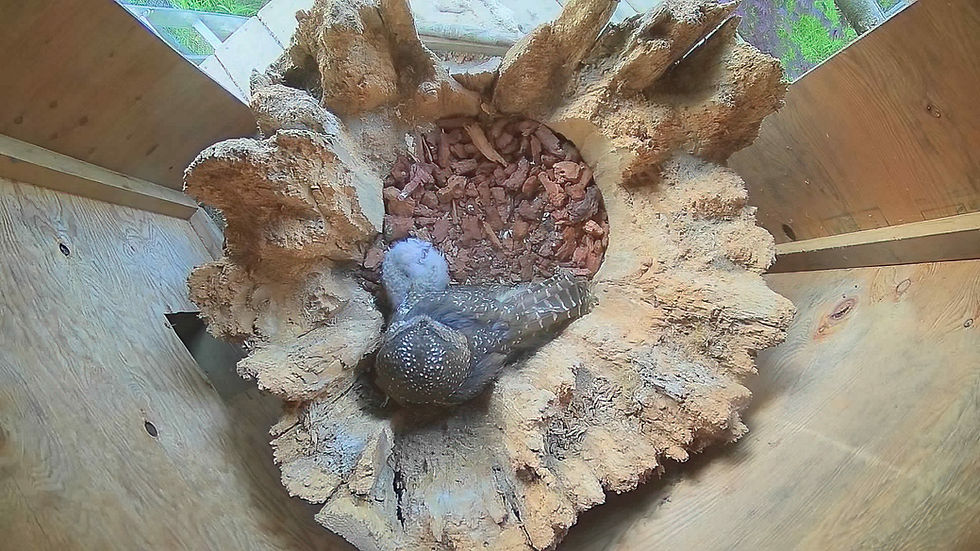Building Relationships: Spô’zêm Nation
- Sep 30, 2022
- 4 min read
Updated: Oct 10, 2023

British Columbia consists of 204 recognized First Nation communities and a goal of the Northern Spotted Owl Breeding Program (NSOBP) has been to further our learning and to rightfully acknowledge indigenous communities and incorporate traditional knowledge into the breeding program and community outreach. The NSOBP is located in Langley and we would like to extend a respectful land acknowledge the Kwantlen First Nation people whose land extends from Richmond and New Westminster in the west, to Surrey and Langley in the south, east to Mission, and to the northernmost reaches of Stave Lake. We recognize and honor the traditional land and skies of the Northern Spotted Owl (NSPOW) and the release sites that have been determined through collaboration between the Province of BC and distinct First Nation communities. These collaborations have been ongoing to support NSPOW’s return to their inherent homelands. These communities will be vital future release activities.
For the 2022 releases, the Province of BC determined that Spô’zêm First Nation would be an ideal release area because it was historically active for the NSPOW, composed of expansive, continuous, and protected habitat, and was already home to the last known wild NSPOW in British Columbia. Consultation, collaboration, and consent with Spô’zêm First Nation is important to these releases and Chief James Hobart spoke eloquently and passionately about this and how it relates to their SkelúleɁ’s message saying “consultation indicates that we're being heard, collaboration affirms that we're being respected, and consent validates the willingness to work towards reconciliation. This project confirms what we've known for a long time. There are indicators in our woods that we call the ‘messengers’ that bring us back the messages of how the health of the woods, the old growth, our kwátłp.”
SkelúleɁ is the name for owl in Nlaka'pamux, the language of the Spô’zêm First Nation.
The plight of the NSPOW is meaningful to the people of Spô’zêm First Nation as it represents the loss of their messengers and the loss of indigenous stewardship. Chief Hobart has expressed his Nations connection to the land through knowledge sharing, “Our identity and cultural traditions are intricately related to our geography and our ecosystems. We are People of the River, the Fraser River, and the surrounding Cascade and Pacific Coastal Mountains. The River is our home, the mountains and mountain valleys are our backyard. The spotted owl has been orally documented amongst our Spô’zêm artists whose renditions of their encaptured spirit lives forever in our hearts, our teachings, our traditions. Like us, they are an important entity in the balance of our sustainable existence.”
Taking guidance from Spô’zêm leaders, members and technical support team, the owls arrived in the land their Ancestors called home. The soft release plan was designed to support the owls in learning their past and connecting to their future.
When the owls first arrived to the soft release aviaries, Chief Hobart included Spô’zêm and Squamish youth to witness parts of the SkelúleɁ’s journey, teaching the next generation on how to continue the work being done today. Chief Hobart welcomed all in attendance as we learned together how to rebuild the health of the land and our future through traditional knowledge and land stewardship. Chief Hobart opened the ceremony with a prayer to bless the owls, the lands, and its guardians. A prayer that taught us to acknowledge those that came before us, but also to think about the younger generations that will come after us.
Over the next few weeks, as we witnessed the owls acclimated to their traditional lands, community members would visit their relatives. Those of us from the NSOBP and other organizations were tasked with monitoring the owls’ wellbeing. We were all able to spend time together, initiating conservations of mutual knowledge sharing, storytelling, and shared lived experiences. In the teachings we received on the indigenous connections between Spô’zêm and SkelúleɁ we developed our own connections to Spô’zêm’s peoples, the land, and the spirit of reconciliation.
The release was a monumental collaborative effort between staff at the NSOBP, members of the Ministry of Land, Water and Resource Stewardship within the Province of BC, the BC Conservation Foundation NSPOW field crew, and Spô’zêm First Nation, and their technical support worker from Sḵwx̱wú7mesh Úxwumixw. Each member of this team had different backgrounds, skills, and knowledge that together allowed for this release to happen. This was an important first step towards restoring the population of NSPOW in British Columbia.
When Chief Hobart was asked about this new pathway forward he said: “What I was most proud of is that we're not sitting there doing nothing. We're doing something. If we make a mistake, we are making a mistake falling forward. I'm most excited about hearing back a year from now, or even two months from now, the sounds of our SkelúleɁ’s calling in their own woods and finding out that they have found a home, have found themselves. Our sky relatives knew our songs, our drums, our traditions. Their ancestral spirits will remember Spô’zêm peoples as their land stewards. That's what's going to excite me. When that next step happens, it will be truly beautiful.”
This article was originally published in our 2022 Newsletter.








